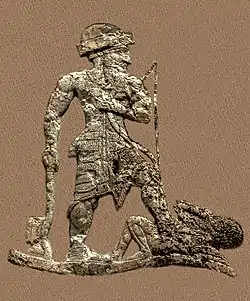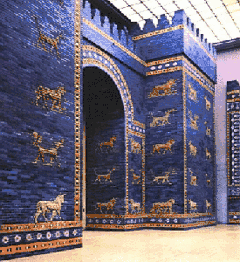Bottom: Approximate location of original Gutium territory
The Guti (/ˈɡuːti/), also known by the derived exonyms Gutians or Guteans, were a people of the ancient Near East. Their homeland was known as Gutium (Sumerian: 𒄖𒌅𒌝𒆠,Gu-tu-umki or 𒄖𒋾𒌝𒆠,Gu-ti-umki).[1][2]
Conflict between people from Gutium and the Akkadian Empire has been linked to the collapse of the empire, towards the end of the 3rd millennium BC. The Guti subsequently overran southern Mesopotamia and formed the Gutian dynasty of Sumer. The Sumerian king list suggests that the Guti ruled over Sumer for several generations following the fall of the Akkadian Empire.[3]
By the 1st millennium BC, usage of the name Gutium, by the peoples of lowland Mesopotamia, had expanded to include all of western Media, between the Zagros Mountains and the Tigris River. Various tribes and places to the east and northeast were often referred to as Gutians or Gutium.[4] For example, Assyrian royal annals use the term Gutians in relation to populations known to have been Medes or Mannaeans. As late as the reign of Cyrus the Great of Persia, the famous general Gubaru (Gobryas) was described as the "governor of Gutium".[5]
Origin

Little is known of the origins, material culture or language of the Guti, as contemporary sources provide few details and no artifacts have been positively identified.[6] As the Gutian language lacks a text corpus, apart from some proper names, its similarities to other languages are impossible to verify. The names of Gutian kings suggest that the language was not closely related to any languages of the region, including Sumerian, Akkadian, Hurrian, Hittite, and Elamite. Most scholars reject the attempt to link Gutian king names to Indo-European languages.[7]
History
25th to 23rd centuries BC
The Guti appear in texts from Old Babylonian copies of inscriptions ascribed to Lugal-Anne-Mundu (fl. circa 25th century BC) of Adab as among the nations providing his empire tribute. These inscriptions locate them between Subartu in the north, and Marhashe and Elam in the south.
Sargon the Great (r. circa 2340 – 2284 BC) also mentions them among his subject lands, listing them between Lullubi, Armanum and Akkad to the north; Nikku and Der to the south. According to one stele, Naram-Sin of Akkad's army of 360,000 soldiers defeated the Gutian king Gula'an, despite having 90,000 slain by the Gutians.
The epic Cuthean Legend of Naram-Sin claims Gutium among the lands raided by Annubanini of Lulubum during the reign of Naram-Sin (c. 2254–2218 BC).[10] Contemporary year-names for Shar-kali-sharri of Akkad indicate that in one unknown year of his reign, Shar-kali-sharri captured Sharlag king of Gutium, while in another year, "the yoke was imposed on Gutium".[11]
Prominence during the early 22nd century BC
During the Akkadian Empire period the Gutians slowly grew in strength and then established a capital at the Early Dynastic city of Adab.[13] The Gutians eventually overran Akkad, and as the King List tells us, their army also subdued Uruk for hegemony of Sumer, in about 2147–2050 BC. However, it seems that autonomous rulers soon arose again in a number of city-states, notably Gudea of Lagash.
The Gutians seem also to have briefly overrun Elam at around the same time, towards the close of Kutik-Inshushinak's reign (c. 2100 BC).[14] On a statue of the Gutian king Erridupizir at Nippur, an inscription imitates his Akkadian predecessors, styling him "King of Gutium, King of the Four Quarters".
The Weidner Chronicle (written c. 500 BC), portrays the Gutian kings as uncultured and uncouth:
Naram-Sin destroyed the people of Babylon, so twice Marduk summoned the forces of Gutium against him. Marduk gave his kingship to the Gutian force. The Gutians were unhappy people unaware how to revere the gods, ignorant of the right cultic practices. Utu-hengal, the fisherman, caught a fish at the edge of the sea for an offering. That fish should not be offered to another god until it had been offered to Marduk, but the Gutians took the boiled fish from his hand before it was offered, so by his august command, Marduk removed the Gutian force from the rule of his land and gave it to Utu-hengal.
Decline from the late 22nd century BC onwards

The Sumerian ruler Utu-hengal, Prince of the Sumerian city of Uruk is similarly credited on the King List with defeating the Gutian ruler Tirigan, and removing the Guti from the country in circa 2050 BC (short chronology).[15]
In his Victory Stele, Utu-hengal wrote about the Gutians:
.jpg.webp)
Gutium, the fanged snake of the mountain ranges, a people who acted violently against the gods, people who the kingship of Sumer to the mountains took away, who Sumer with wickedness filled, who from one with a wife his wife took away from him, who from one with a child his child took away from him, who wickedness and violence produced within the country..."
Following this, Ur-Nammu of Ur ordered the destruction of Gutium. The year 11 of king Ur-Nammu also mentions "Year Gutium was destroyed".[18] However, according to a Sumerian epic, Ur-Nammu died in battle with the Gutians, after having been abandoned by his own army.
A Babylonian text from the early 2nd millennium refers to the Guti as having a "human face, dogs’ cunning, [and] monkey's build".[19] Biblical scholars believe that the Guti may be the "Koa" (qôa), named with the Shoa and Pekod as enemies of Jerusalem in Ezekiel 23:23,[20] which was probably written in the 6th century BC.
Modern connection theories
The historical Guti have been regarded by several scholars as having contributed to the ethnogenesis of the Kurds.[21][22]
 |
| History of Greater Iran |
|---|
References
- ↑ "The Sumerian King List line 308". ETCSL. Retrieved 19 December 2010.
- ↑ "The Cursing of Agade". ETCSL. Retrieved 18 December 2010.
- ↑ "Sumerian king list page 18". ETCSL.
- ↑ Parpola, S., "Neo-Assyrian Toponyms", (AOAT 6). Kevelaer and Neukirchen-Vluyn: Butzon & Bercker and Neukirchener Verlag, 1970
- ↑ Oppenheim, A. Leo, "VIII. Assyrian and Babylonian Historical Texts", The Ancient Near East: An Anthology of Texts and Pictures, edited by James B. Pritchard, Princeton: Princeton University Press, pp. 246-286, 2011
- ↑ Bryant, Edwin; Patton, Laurie L. (2004). The Indo-Aryan Controversy. Routledge. ISBN 9780700714636.
- ↑ Mallory, J.P.; Mair, Victor H. (2000). The Tarim Mummies. London: Thames & Hudson. pp. 281–282. ISBN 978-0-500-05101-6.
- ↑ Osborne, James F. (2014). Approaching Monumentality in Archaeology. SUNY Press. p. 123. ISBN 9781438453255.
- ↑ Edwards, I. E. S.; Gadd, C. J.; Hammond, N. G. L. (1971). The Cambridge Ancient History. Cambridge University Press. p. 444. ISBN 978-0-521-07791-0.
- ↑ Ebling, Bruno Erich (1928). Reallexikon der Assyriologie und vorderasiatischen Archäologie [Encyclopedia of Assyriology and Near Eastern Archaeology] (in German). W. de Gruyter. ISBN 9783110037050.
- ↑ "Year-names for Sharkalisharri". University of California Los Angeles.
- ↑ The Sumerian Kings List (PDF). p. 119, note 305.
- ↑ M. Molina, "The palace of Adab during the Sargonic period", D. Wicke (ed.), Der Palast im antiken und islamischen Orient, Colloquien der Deutschen Orient-Gesellschaft 9, Wiesbaden: Harrassowitz 2019, pp. 151-20
- ↑ Sicker, Martin (2000). The Pre-Islamic Middle East. p. 19.
- ↑ "The victory of Utu-ḫeĝal". ETCSL.
- 1 2 Full transcription and translation in: "CDLI-Found Texts". cdli.ucla.edu.
- ↑ Thureau-Dangin, Fr. (1912). "La Fin de la Domination Gutienne" [The End of Gutian Domination]. Revue d'Assyriologie et d'archéologie orientale (in French). 9 (3): 111–120. ISSN 0373-6032. JSTOR 23283609.
- ↑ "Year names of Ur-Nammu". cdli.ucla.edu.
- ↑ Ansky, S.. "The Cursing of Akkade". The Harps that Once..., edited by David G. Roskies, New Haven: Yale University Press, pp. 359-374, 1992
- ↑ See, for example, Douglas, J. D.; Tenney, Merrill C. (2011). Zondervan Illustrated Bible Dictionary (3rd ed.). HarperCollins. p. 1897.
- ↑ Stokes, Jamie, ed. (2009). "Kurds". Encyclopedia of the Peoples of Africa and the Middle East. Facts on File. p. 380. ISBN 9781438126760.
- ↑ Erdbrink, D. P. (1968). "Reviewed Work: Türken, Kurden und Iraner seit dem Altertum by E. von Eickstedt". Central Asiatic Journal. Harrassowitz Verlag. 12 (1): 64–65. JSTOR 41926760.

.jpg.webp)



.jpg.webp)

